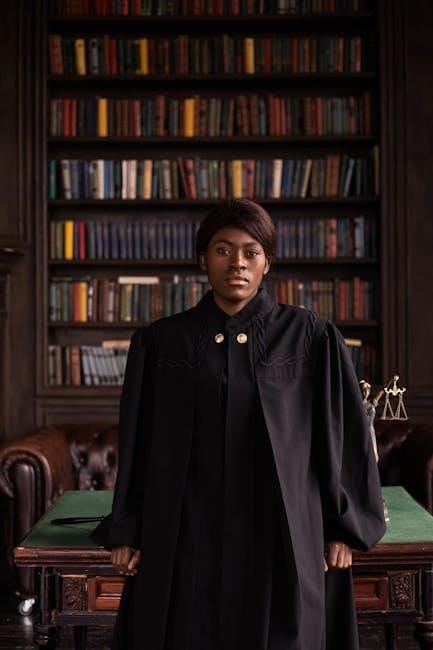Act II shifts to the Proctors’ home‚ blending private tensions with public accusations. It explores internal conflicts‚ strained relationships‚ and the emergence of key themes and symbols.
Setting of Act II
Act II of The Crucible primarily takes place in the Proctor household‚ eight days after the events of Act I. The setting shifts from the public‚ communal space of Reverend Parris’s home to the private‚ intimate environment of John and Elizabeth Proctor’s house. This change emphasizes the intrusion of public hysteria into the domestic sphere. The scene begins in the cold‚ sparse common room of the Proctors’ home‚ where the tension between John and Elizabeth is palpable. The setting reflects the emotional chill between the couple‚ as well as the broader societal chill of fear and suspicion gripping Salem. Later‚ the arrival of Reverend Hale and Ezekiel Cheever brings the witch-hunt directly into the Proctors’ private space‚ blurring the line between public and private life. This setting underscores the claustrophobic atmosphere of fear and accusation permeating the community.
Act II of The Crucible unfolds in the Proctor household‚ where John and Elizabeth’s strained relationship is evident. Their conversation reveals lingering tension from John’s affair with Abigail. Mary Warren‚ now a court official‚ arrives with a poppet she made‚ symbolizing her newfound authority. She reveals that Elizabeth has been accused of witchcraft‚ intensifying the conflict. Reverend Hale visits‚ questioning the Proctors about their faith and practices‚ highlighting the invasive nature of the witch trials; John’s inability to recall the commandment against adultery underscores his internal guilt. The act escalates when Ezekiel Cheever arrives to arrest Elizabeth‚ citing Abigail’s accusation. John tears up the warrant‚ defying the court‚ while Mary‚ fearing Abigail’s retaliation‚ refuses to support John publicly. The act ends with Elizabeth’s arrest‚ deepening the family’s despair and the community’s hysteria.

Character Development in Act II
John Proctor’s guilt and internal conflict deepen‚ while Elizabeth’s coldness reflects unresolved tension. Mary Warren’s transformation into a court official highlights her newfound authority and fear of Abigail.
John Proctor’s Internal Conflict
John Proctor’s internal conflict in Act II stems from his guilt over his affair with Abigail Williams and his strained relationship with Elizabeth. His inability to fully reconcile with Elizabeth reflects his lingering remorse and the weight of his past actions. Proctor struggles with feelings of hypocrisy‚ as he condemns the witch trials while hiding his own moral failure. When Mary Warren reveals that Elizabeth has been accused‚ Proctor’s fear of losing her intensifies his internal turmoil. His frustration grows as he realizes the futility of challenging the court’s authority‚ yet he resolves to protect his wife‚ even if it means risking his own reputation. This conflict highlights Proctor’s moral integrity and his ultimate decision to confront the hypocrisy of the trials‚ showcasing his complexity as a character.
Elizabeth Proctor’s Strained Relationship with John
Elizabeth Proctor’s relationship with John remains tense in Act II‚ as the lingering effects of his affair with Abigail Williams continue to cast a shadow. Elizabeth’s cold demeanor and constant suspicion reflect her unresolved pain and mistrust. Despite John’s efforts to move past his infidelity‚ Elizabeth’s frosty behavior creates a strained atmosphere in their home. When John suggests bringing flowers into the house to lighten the mood‚ Elizabeth’s dismissive response underscores her emotional distance. Her concern over John’s potential interactions with Abigail‚ coupled with her suggestion that he confront Abigail directly‚ reveals her deep-seated fears and insecurities. The tension between them escalates when Mary Warren reveals Elizabeth’s accusation‚ forcing Elizabeth to confront the reality of her precarious situation and the fragility of their marriage. This strain highlights the emotional toll of betrayal and the challenges of reconciliation in their relationship.
Mary Warren’s Role and Transformation
Mary Warren undergoes a significant transformation in Act II‚ evolving from a timid servant to a confident‚ yet conflicted‚ participant in the witch trials. Initially‚ she is torn between obeying Elizabeth and her newfound importance as an official of the court. Her decision to disobey Elizabeth and attend the trials reflects her desire for empowerment and recognition. Mary’s role as an accuser grants her a sense of authority‚ but it also exposes her to moral ambiguity. When she reveals that Elizabeth has been accused‚ she demonstrates a mix of loyalty and fear‚ ultimately failing to protect her mistress. Her transformation highlights the psychological impact of the trials‚ as she struggles between truth and the pressure to conform to the hysteria. This internal conflict underscores her vulnerability and the tragic consequences of her actions.
Reverend Hale’s Growing Doubts
Reverend Hale’s confidence in the witch trials begins to waver in Act II as he witnesses the escalating hysteria and questionable evidence. Initially‚ he arrives at the Proctors’ home with an air of authority‚ intent on uncovering signs of witchcraft. However‚ his demeanor shifts as he learns of Elizabeth’s accusation and the dubious nature of the charges. Hale’s faith in the court’s infallibility is shaken when he sees the fear and manipulation driving the accusations. Proctor’s passionate defense of his wife and his criticism of the court’s methods further erode Hale’s certainty. By the end of the act‚ Hale appears troubled‚ grappling with the moral implications of his role in the trials. His growing doubts reflect the broader theme of questioning authority and the destructive power of unchecked fear.

Themes in Act II
Act II explores themes of guilt‚ redemption‚ and the destructive power of fear. It highlights the clash between private morality and public hysteria‚ revealing societal tensions and individual struggles.

The Blurring of Public and Private Spheres
In Act II‚ the boundaries between public and private life dissolve as the witch trials intrude into the Proctors’ home. The private tensions between John and Elizabeth are overshadowed by the public accusations of witchcraft. Reverend Hale’s visit exemplifies this blurring‚ as he investigates their private lives‚ questioning their religious practices and personal beliefs. The court’s intrusion into domestic affairs highlights how fear and hysteria erode the sanctity of the home. Even Mary Warren’s role as a court official bridges the gap between her private loyalty to the Proctors and her public duties. This theme underscores the pervasive reach of the witch trials‚ demonstrating how private matters become public weapons in the hands of the court. The act vividly portrays a society where personal secrets and private conflicts are exploited for public condemnation.
The Ambiguity of Evidence and Truth
Act II highlights the ambiguity of evidence and truth through the manipulation of circumstances and testimony. The court relies on questionable evidence‚ such as the poppet found in the Proctors’ home‚ which Abigail uses to accuse Elizabeth of witchcraft. Mary Warren‚ though initially truthful‚ becomes entangled in the court’s web of deceit‚ her own words twisted against her. Reverend Hale’s interrogation of John Proctor reveals how personal beliefs and minor omissions‚ like forgetting a Ten Commandment‚ are misconstrued as evidence of guilt. The act illustrates how fear and paranoia distort reality‚ turning innocuous actions into damning evidence. This ambiguity underscores the dangerous unpredictability of the trials‚ where truth is sacrificed for the sake of public hysteria and personal agendas.

Symbolism in Act II
In Act II‚ symbols like the poppet and needle emphasize manipulation and betrayal‚ reflecting the play’s themes of accusation and moral decay.

The Poppet as a Symbol of Accusation
The poppet‚ crafted by Mary Warren‚ serves as a potent symbol of accusation and manipulation in Act II. Initially a harmless doll‚ it becomes a tool of deceit when a needle is discovered inside it. Abigail uses this object to falsely accuse Elizabeth of witchcraft‚ claiming the needle was used to harm her. The poppet embodies the destructive power of false accusations‚ as it transforms a simple trinket into “evidence” of wrongdoing. This symbol highlights Miller’s exploration of how everyday items can be twisted to fuel hysteria and betrayal. The poppet’s significance lies in its role as a tangible representation of the girls’ manipulation and the court’s willingness to accept dubious evidence. It underscores the theme of how fear and lies can distort reality‚ leading to devastating consequences.

The Needle as a Symbol of Betrayal
The needle embedded in Mary Warren’s poppet symbolizes betrayal and manipulation in Act II. Discovered by Ezekiel Cheever‚ it is used as “evidence” that Elizabeth Proctor sent her spirit to harm Abigail. This object‚ once a simple sewing tool‚ becomes a weapon of deceit‚ representing the betrayal of trust within the Proctor household and the community. The needle signifies how minor actions‚ like Mary’s careless stitching‚ are exploited to destroy reputations. It reflects the destructive power of lies and the willingness of others to believe false accusations. The needle’s presence in the poppet underscores the theme of betrayal‚ as it directly leads to Elizabeth’s arrest‚ fracturing the Proctors’ already strained relationship. This symbol encapsulates the pervasive distrust and hysteria driving the witch trials‚ highlighting how innocent objects can be twisted to serve malicious purposes.

Historical Context and Relevance
Act II reflects the Salem witch trials’ historical context‚ mirroring McCarthyism’s mass hysteria. Miller critiques fear-driven accusations‚ echoing Red Scare paranoia‚ highlighting timeless societal fears.
Parallels to the Salem Witch Trials
Act II of The Crucible mirrors the hysteria and paranoia of the Salem Witch Trials‚ where fear and false accusations dominated society. Miller depicts how accusations escalate‚Much like the historical trials‚ the play highlights the dangers of unchecked power and mass hysteria. The court’s reliance on “spectral evidence” and the fear of the Devil reflect the same flawed legal practices used in Salem. Characters like Mary Warren and Abigail Williams embody the manipulated accusers from the trials‚ while John Proctor symbolizes the innocent victims targeted by false accusations. The play also explores the societal tensions‚ such as the Puritan fear of the unknown and the belief in supernatural forces‚ which fueled the witch hunts. By paralleling these events‚ Miller critiques the destructive nature of fear‚ superstition‚ and the erosion of justice‚ offering a timeless commentary on human vulnerability to mass hysteria.

Study Questions for Act II
How does Mary Warren’s role in the court affect her relationship with the Proctors? Why does Proctor struggle to recall the Ten Commandments? What significance does the poppet hold in Act II? How does Hale’s growing doubt impact the plot? Why does Elizabeth believe Abigail accuses her? What does the argument between John and Elizabeth reveal about their marriage? How does the theme of guilt influence Proctor’s actions? Why does Mary Warren fear defying Abigail? What does the needle in the poppet symbolize about betrayal? How does the court’s use of “evidence” reflect the ambiguity of truth in Salem?

Key Questions to Guide Understanding
What role does guilt play in shaping Proctor’s decisions in Act II? How does Mary Warren’s transformation reflect the societal pressures of Salem? In what ways does Elizabeth’s cold demeanor toward John symbolize their marital tensions? Why does Hale’s growing doubt about the trials mark a turning point in his character? How does the poppet serve as a catalyst for the accusations against Elizabeth? What does Proctor’s inability to recall the commandment against adultery reveal about his internal conflict? How does Abigail’s manipulation of the court highlight the theme of false accusations? Why does Mary Warren’s fear of Abigail prevent her from telling the truth? How does the needle in the poppet symbolize betrayal and deception? What does the conflict between public accusations and private truths reveal about Salem’s society? How does the act’s focus on the Proctor household illustrate the invasion of private lives by public hysteria?
